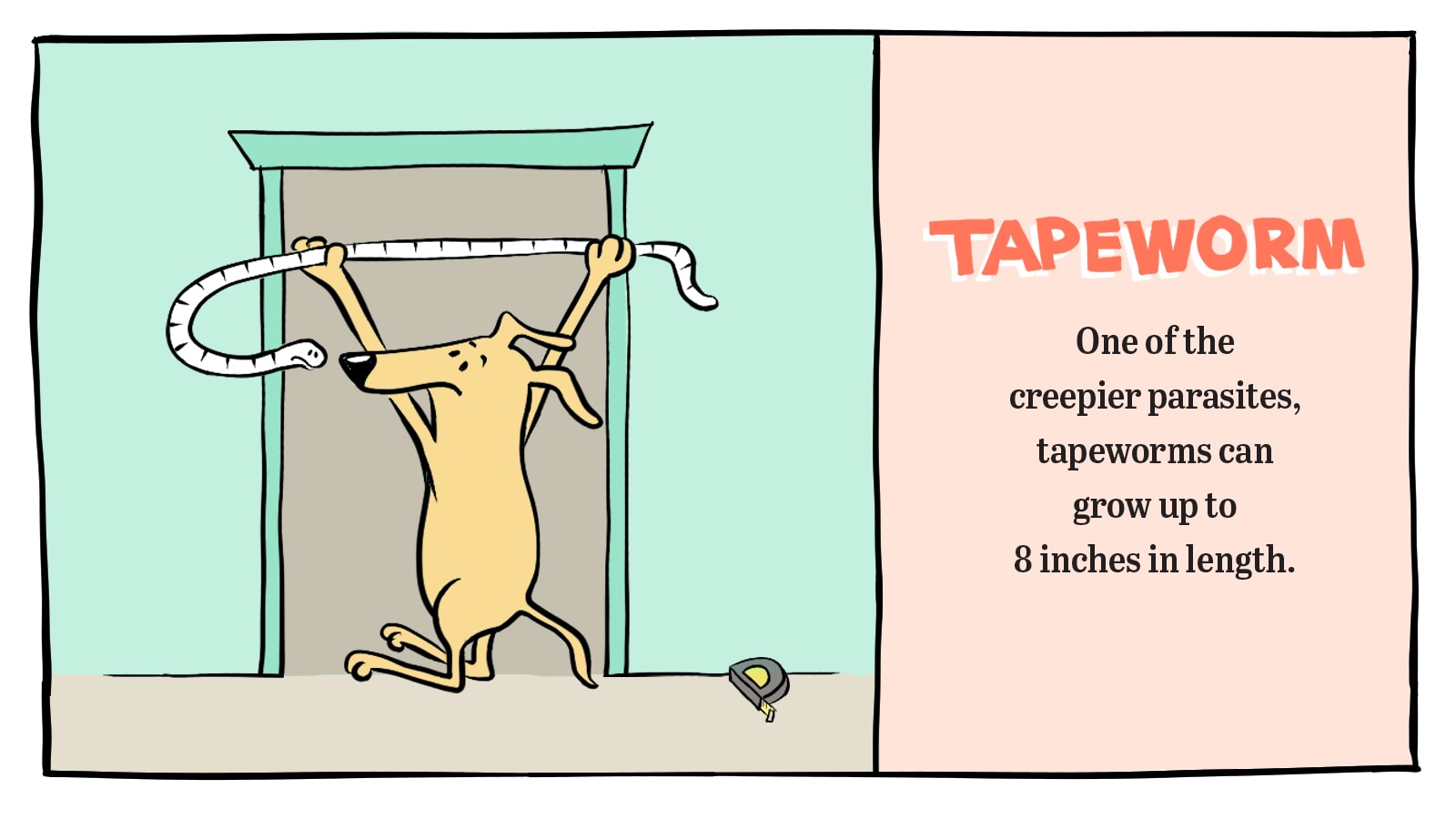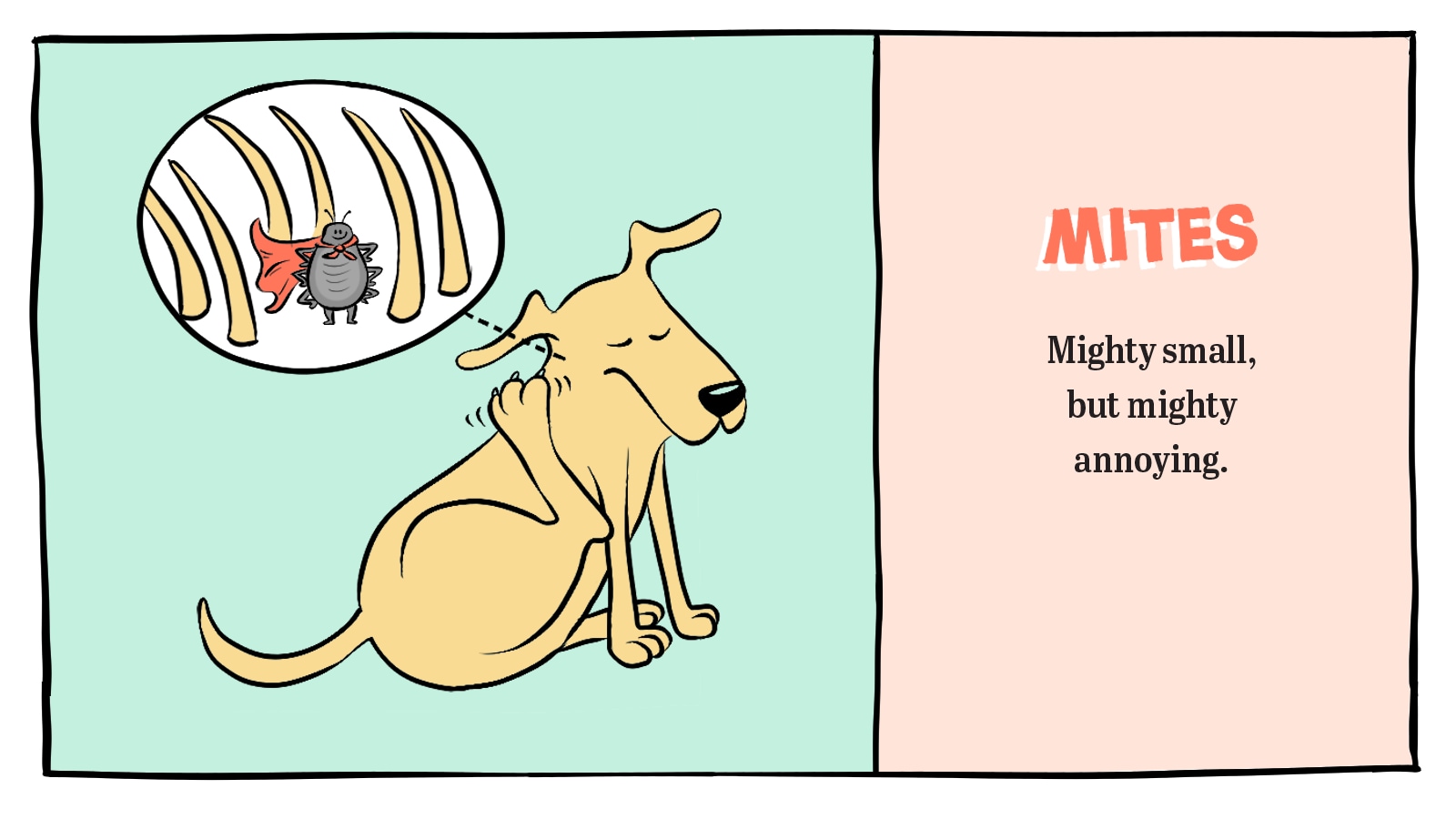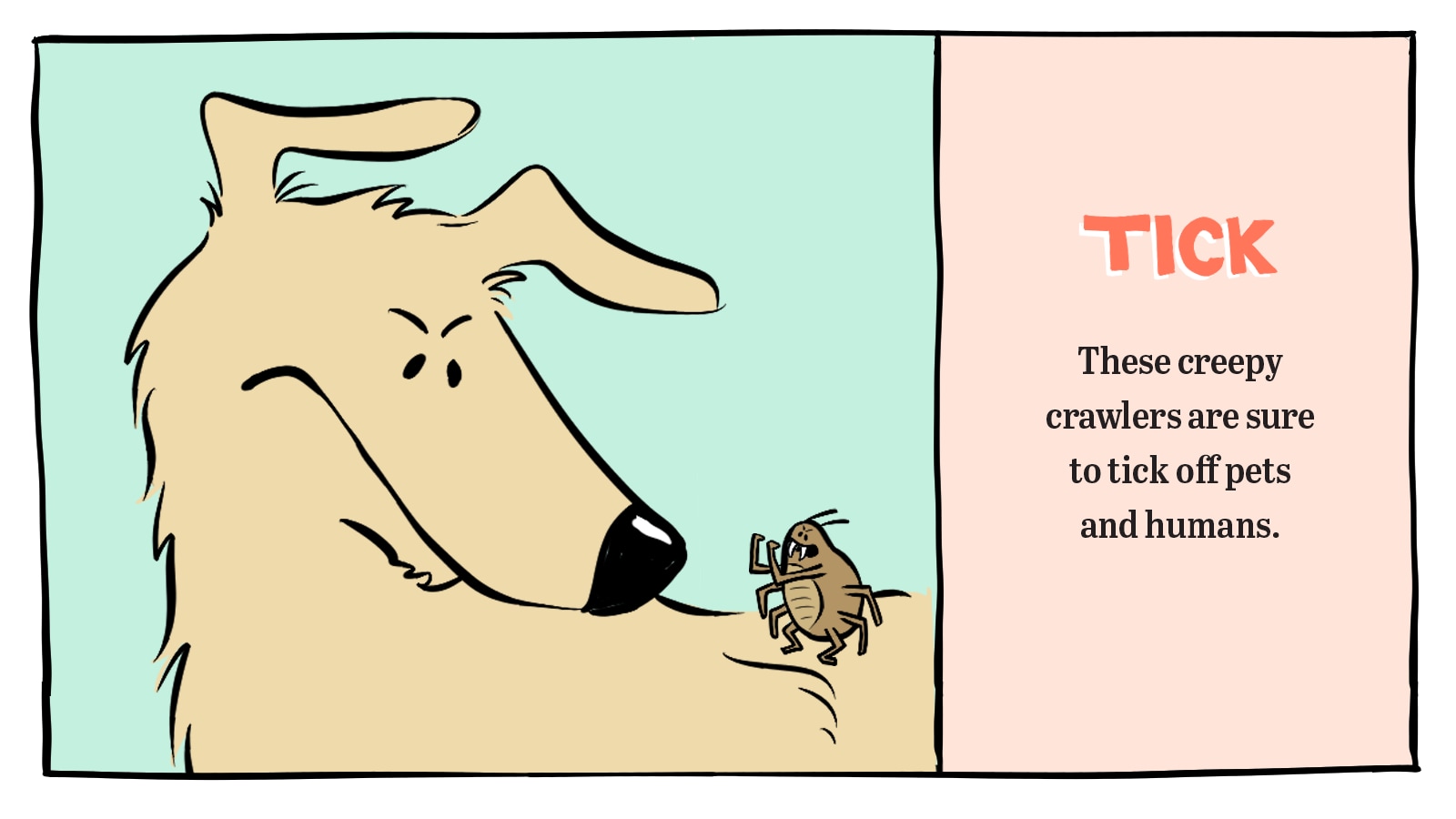A big part of keeping your canine companion healthy is keeping him parasite-free. Of course, parasites in dogs are not fun to deal with, so it’s important to be knowledgeable and proactive about them.
Susan Barrett, DVM, assistant professor at The Ohio State University College of Veterinary Medicine in Columbus, answers your top questions about the six most common parasites in dogs and symptoms to look out for.
6 Common External and Internal Parasites in Dogs
1. Hookworms

By Bambi Edlund
This intestinal parasite in dogs is not pretty to look at—actually its name comes from its hook-like mouthparts, which are used to latch onto a dog’s intestines. Dr. Barrett explains how these creepy worms infect dogs and, most importantly, how to prevent them.
How do dogs get hookworms?
The most common way dogs get hookworms is by ingesting hookworm larvae from contaminated areas, which can include infested soil or feces. Nursing puppies most commonly contract hookworms via their mother’s milk.
What are the signs of hookworms in dogs?
Adult dogs rarely show any symptoms if they have hookworms. In the rare occasion they do, adult dogs may only have some diarrhea.
Puppies often are more severely affected by hookworms and may experience diarrhea, vomiting, weight loss, pale gums and weakness from blood loss. Hookworms can be fatal in untreated puppies. Because puppies’ immune systems are less mature, they struggle more to fight the parasite.
What are the best ways to prevent hookworms in dogs?
The best prevention is to keep your pet on a monthly heartworm preventative that also protects against hookworms. Avoiding contaminated environments is ideal, as well, but can be hard to identify.
How do you treat hookworms in dogs?
If your dog tests positive for a hookworm infection, your vet may recommend a deworming (or “anthelmintic”) medication. For puppies infected with hookworms from their mother’s milk, your veterinarian might recommend several rounds of deworming while initiating a monthly preventative.
Learn more about how to treat and prevent hookworms in dogs.
2. Tapeworms

By Bambi Edlund
Tapeworms are notorious for being long worms. This lengthy parasite might start at around a quarter of an inch and grow up to 8 inches. Don’t fret, though—Dr. Barrett explains how to avoid this scary flatworm.
How do dogs get tapeworms?
The most common cause of tapeworms in dogs is ingesting fleas that are infested with tapeworm larvae, known as cysticercoids. Dogs also can contract tapeworms from infested rabbits, rodents or reptiles.
What are the symptoms of tapeworms in dogs?
Many dogs do not show symptoms of tapeworm infection. In the rare case that symptoms are shown, it might be itching around their rear end (e.g. scooting or licking the area).
Pet parents also might notice small segments of the worm in or around the dog’s anus or in the hair around the anus. When dried, these segments look like a grain of rice.
What are the best ways to prevent tapeworms in dogs?
The best ways to prevent tapeworms is to use good flea prevention and keep your dog from eating any infested rabbits and rodents.
How do you treat tapeworms in dogs?
If you think your pet has tapeworms, your vet can recommend a deworming medication, which may be injected or given orally.
3. Roundworms

By Bambi Edlund
Roundworms are exactly what they sound like: round worms. They often are found in the intestinal tract and resemble cooked spaghetti. Dr. Barrett lays out the details on this unappetizing intestinal parasite.
How do dogs get roundworms?
Dogs contract roundworms by eating their eggs in a contaminated environment where infested dogs or other infested animals have been or by eating another host (usually rodents). Puppies commonly contract roundworms from their mother across the placenta.
What are the symptoms of roundworms in dogs?
Most adult dogs do not show any symptoms if they have roundworms. Puppies sometimes have a pot-bellied appearance, may not gain weight appropriately, might have a poor haircoat and may experience vomiting and diarrhea from this parasite.
What are the best ways to prevent roundworms in dogs?
The best way to prevent roundworms is to keep your dog on a monthly heartworm preventative that also protects against roundworms. Avoiding contaminated environments is ideal, but these might be hard to identify.
How do you treat roundworms in dogs?
Roundworms are treated with a deworming product as recommended by your veterinarian. For puppies infected with roundworms via their mother’s placenta, your veterinarian might recommend several rounds of deworming while initiating a monthly preventative.
4. Fleas

By Bambi Edlund
Everyone agrees that fleas are a drag. Though you might have your pet on a flea medicine already, it may be useful to know where these pests come from in the first place. Dr. Barrett discusses how dogs get fleas and how to prevent them.
How do dogs get fleas?
Dogs most commonly get fleas from an infested environment, such as homes, kennels or yards, where fleas can be transferred from infested dogs. Adult fleas can transfer from one infested animal to another as well.
What are the symptoms of fleas on dogs?
The most common symptom of a flea infestation on a dog is itching. Dogs who are allergic to fleas also will have scabs and hair loss, typically in the “pants” region (back near the tail and the back legs). In severe cases, this can affect the whole body. Parents also might notice fleas on the haircoat, or see “flea dirt” (flea feces), which may turn pink/red when bathing.
What are the best ways to prevent fleas on dogs?
There are many effective topical and oral flea prevention products available. Consult with your veterinarian for the best choice for your pet.
How do you get rid of fleas?
There are many dog flea and tick treatments on the market. If an infestation is present, control should focus on treating the pet AND on eliminating fleas (and their eggs) in the environment.
Read more about flea control and prevention.
5. Mites

By Bambi Edlund
Mites can wreak havoc on a dog’s skin and fur. Luckily, there’s a way to keep these parasites at bay and under control, as Dr. Barrett explains.
How do dogs get mites?
There are multiple kinds of mites, but the two most common found in dogs are Demodex species and Sarcoptes species. Demodex mites are a natural inhabitant of the dog’s skin and are not contagious, meaning they do not transfer from dog to dog or dog to human. Overgrowth of the number of Demodex mites (demodicosis or demodectic mange) generally is thought to be related to a compromised immune system, but the underlying cause often cannot be identified. Demodicosis is seen most commonly in puppies.
Sarcoptes is a contagious mite that causes sarcoptic mange in dogs. Canines get these mites from an infected animal, such as other dogs, horses and cattle. It is important to note that humans can develop self-limiting infection (meaning it should resolve itself) from contact with infested dogs.
What are the symptoms of mites on dogs?
Demodicosis most commonly presents as one or a few patches of hair loss with no other symptoms; this is localized demodicosis. It also can affect large areas of the body, thus called generalized demodicosis. In severe cases, there may be skin infections—scabs, itching, oozing—and the dog might feel ill.
Sarcoptes mites cause intense itching, often centered on the ears and elbows. You might notice thick, dry crusts on the edges of the dog’s ears and on the elbows. Humans in contact with the infected dog also can develop itchy lesions
What are the best ways to prevent mites on dogs?
There is no labeled preventative medication for Demodex mites. Veterinarians generally recommend not breeding dogs who develop demodicosis because there is a genetic component to localized demodicosis (this is unclear for generalized demodicosis). Unspayed female dogs with generalized demodicosis tend to experience recurrences during heat cycles, so vets usually recommend spaying them. Use of some flea products will treat demodicosis, but this has not been evaluated for prevention.
Because Sarcoptes mites are highly contagious, keep your dog away from infested animals. This can be challenging because, early in the infection, dogs may not be itching, so it can be hard to know if they are infected. The good news is that there are many effective treatments for sarcoptic mange, and routine use of flea preventatives will prevent infection.
How do you treat mites on dogs?
If you’re dealing with localized demodicosis, the problem is likely to resolve itself. For generalized cases, long-term dog medications may be necessary.
There are many effective treatments for sarcoptic mange. Treatment ranges from medicated baths and dips to injections and oral medications.
6. Ticks

By Bambi Edlund
Found in every U.S. state, there’s no escape from the feared tick. That being said, there are ways to avoid them and protect your pet. Dr. Barrett gives us the details.
How do dogs get ticks?
Dogs get ticks from the environment. Common places are grasses and woods in rural areas as well as from raccoons, rodents, squirrels and other mammals that bring them into the backyards—even in the city. They also can infest kennels.
Ticks await their intended victims on the tips of grasses and shrubs. They can detect the breath and body odors of their intended hosts and can even detect shadows and well-used paths to find the passing host.
What are the symptoms of ticks on dogs?
The most common symptom of ticks is finding a tick attached to the dog’s skin. It might be engorged after it takes a blood meal from the host. The tick’s saliva contains an anesthetic agent, so their bites are not generally painful. Tick saliva also can transmit a variety of illnesses to hosts, including Rocky Mountain spotted fever and Lyme disease.
Symptoms of tick-borne illness vary widely with the type of disease. Common signs are fever, lethargy, inappetence, limping or swollen joints and enlarged lymph nodes.
What are the best ways to prevent ticks on dogs?
There are very effective tick-control products for dogs today, both topical and oral. Consult your veterinarian for the best product for your pet.
Keeping dogs on leash and limiting roaming, especially in rural environments, can help as well. Make sure kennels and other enclosures aren’t infested with ticks.
How do you get rid of ticks?
There are many dog flea and tick treatments on the market. Again, talk to your veterinarian for the best product for your pet.
Learn the truth about common tick myths.
Parasites in dogs can be a pain, but luckily, with the right type of prevention medication, you can keep your dog happy and healthy for years to come.
By Lauren Bronston
From graduating with an Audio Engineering degree in Chicago to writing about lovable pets at Chewy’s headquarters in South Florida, Lauren Bronston loves immersing herself in the creative. When she’s not writing and editing pet content, Lauren does even more writing in her spare time and has a passion for writing scripts for short film, TV pilots and even feature length films! To relax and unwind, she loves meticulously building music playlists and her vinyl collection.
Learn more about parasites in dogs
Share:















